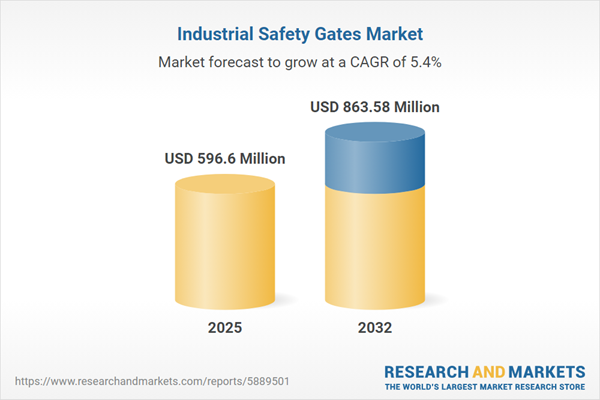Speak directly to the analyst to clarify any post sales queries you may have.
The industrial safety gates market is navigating fast-changing operational risks and growing compliance demands, requiring senior decision-makers to stay informed about the latest market shifts and solution advancements. This overview offers targeted insights to help organizations protect their workforce, enhance infrastructure, and future-proof investments.
Industrial Safety Gates Market Snapshot
The global industrial safety gates market is valued at USD 565.16 million in 2024 and is projected to reach USD 596.60 million by 2025, expanding further to USD 863.58 million by 2032. Sustained growth reflects modernization trends in manufacturing, logistics, and healthcare, as organizations adapt safety practices to evolving process complexity and regulatory scrutiny. Increasing demand in North America, Europe, Asia-Pacific, and the Middle East signals a widespread commitment to workplace protection and compliance. Regulatory pressure continues to be a key motivator behind the accelerated adoption of innovative safety gate technologies, automated solutions, and connected systems across major industries.
Scope & Segmentation of the Industrial Safety Gates Market
- Gate Types: Bi-folding, sliding, swing, and telescopic gates offer installation flexibility for warehouses with limited space, as well as adaptable options for modern production sites and controlled zones.
- End-Use Industries: Automotive, healthcare, logistics, manufacturing, and food & beverage sectors turn to safety gate systems to protect personnel and assets as they respond to more stringent workplace safety standards.
- Operation Mechanisms: Both manual and automated gates—driven by electric, hydraulic, or pneumatic systems—provide support for new builds and retrofits alike in diverse industrial environments.
- Materials: Aluminum, stainless steel, steel, and PVC gates are selected for their ability to withstand chemical exposure, mechanical impact, and continuous operation, making them suitable for harsh or highly sanitized settings.
- Distribution Channels: Organizations use direct sales, OEM collaborations, distributor relationships, retail channels, and e-commerce for customized procurement and timely delivery tailored to operational priorities.
- Safety Features: Integrated technologies such as emergency stop functions, light curtains, edge-sensitive devices, and advanced sensors help ensure access point safety and reinforce regulatory compliance.
- Regional Coverage: Uptake is strong in the United States, China, Germany, India, and the UAE, where expanding infrastructure and local standards demand ongoing adaptation of safety solutions.
- Leading Companies Profiled: Major industry participants include Pilz GmbH & Co. KG, Schmersal GmbH & Co. KG, Fortress Interlocks Limited, Euchner GmbH + Co. KG, Rockwell Automation, ABB Ltd, Siemens Aktiengesellschaft, Honeywell International Inc., ifm electronic GmbH, and Schneider Electric SE, all known for advancements in integrated safety gate technology.
Key Takeaways for Senior Decision-Makers
- Integrating advanced sensor systems and analytics supports predictive maintenance, improving operational uptime and strengthening proactive risk management strategies for critical sites.
- Evolving regulatory standards encourage investment in workforce training and process upgrading, resulting in higher compliance and minimizing liabilities for employers.
- Selecting gate materials appropriate to the operational environment—such as chemical-resistant metals for processing plants or durable alloys for heavy industry—directly enhances safety and longevity.
- Adoption of automation and embedded safety technologies expands the scope for managed service offerings, including flexible support contracts for multi-site operations or facilities with specialized needs.
- Developing long-term supplier partnerships and utilizing bundled procurement contracts allows organizations to adjust quickly to changing business demands and streamline project execution.
Tariff Impact: Navigating Raw Material Pressures
Current U.S. tariffs on imported steel and aluminum are increasing production costs for safety gate manufacturers. Key sectors including logistics and automotive are mitigating these effects by diversifying sourcing strategies, expanding supplier networks, and adopting flexible contracts, which contribute to greater supply chain robustness and reduce exposure to volatility in raw material pricing.
Methodology & Data Sources
This analysis is grounded in input from over 200 industry professionals—including manufacturing leaders and compliance experts—using technical evaluations, structured surveys, and in-depth financial analysis. Triangulation and cross-verification ensured consistent and accurate insights throughout this research.
Why This Report Matters to Your Business
- Delivers practical, detailed segmentation for planning investments in industrial safety gate systems and supporting technologies, facilitating better capital allocation for evolving safety needs.
- Arms procurement leaders and teams with knowledge to respond proactively to regulatory shifts, raw material cost changes, and supply chain developments, securing business operations and continuity.
- Enables senior leaders to align safety compliance initiatives with operational targets, providing a clear roadmap for regulatory adaptation and workplace risk reduction.
Conclusion
This report offers senior decision-makers concise analysis and market guidance to inform strategic choices, enhance workplace safety, and reinforce business resilience as the industrial landscape shifts and safety standards evolve.
Additional Product Information:
- Purchase of this report includes 1 year online access with quarterly updates.
- This report can be updated on request. Please contact our Customer Experience team using the Ask a Question widget on our website.
Table of Contents
3. Executive Summary
4. Market Overview
7. Cumulative Impact of Artificial Intelligence 2025
Companies Mentioned
The companies profiled in this Industrial Safety Gates market report include:- Pilz GmbH & Co. KG
- Schmersal GmbH & Co. KG
- Fortress Interlocks Limited
- Euchner GmbH + Co. KG
- Rockwell Automation, Inc.
- ABB Ltd
- Siemens Aktiengesellschaft
- Honeywell International Inc.
- ifm electronic GmbH
- Schneider Electric SE
Table Information
| Report Attribute | Details |
|---|---|
| No. of Pages | 190 |
| Published | October 2025 |
| Forecast Period | 2025 - 2032 |
| Estimated Market Value ( USD | $ 596.6 Million |
| Forecasted Market Value ( USD | $ 863.58 Million |
| Compound Annual Growth Rate | 5.4% |
| Regions Covered | Global |
| No. of Companies Mentioned | 11 |









